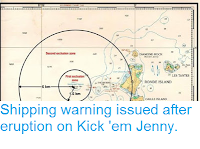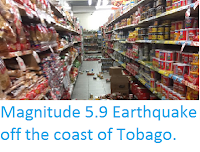Forty two people have now been confirmed dead in incidents relating to Hurricane Irma in the Caribbean. Eleven people have died in the French colonies of Saint Martin and Saint Barthélemy, ten on the island of Cuba, five in the state of Florida, four each on the Dutch colony of Sint Maartin and the US Virgin Islands, three each in Peurto Rico and Barbuda, and one each in Anguila and Barbados. The hurricane was a Catagory Five tropical storm when it hit the Leeward Islands, with sustained winds in excess of 250 km per hour and gusts considerably stronger. By the time it hit Florida it had dropped to Catagory Four storm,with winds in excess of 210 km per hour and larger gusts. However the majority of the damage has been done by storm surges, with waves in excess of five meters recorded on the Florida Keys, and in excess of three meters on the mainland.
Flooding in Havana, Florida, on 10 September 2017 following the passage of Hurricane Irma. Yamil Lage/AFP/Getty Images.
Hurricane Irma swept across Barbuda om 5-6 September, destroying 95% of the buildings on the island, including its only hosptital. Despite this only a single fatality has been reported on the island, with two more people missing and three more injured. The storm hit the island of Saint Martin, which is divided between the French colony of Saint Martin and the Dutch colony of Sint Maartin, the following morning, killing eleven people and injuring 40 more on the French part of the island, where about 90% of the buildings have been damaged and about 60% are unihabitable, and killing four and injuring 23 on the Dutch part, where about 70% of the buildings have been damaged.
Storm damage on Sint Maartin following the passage of Hurricane Irma. Gerban Van Es/Zuma Press.
The storm hit the British colony of Antigua later the same day, agian causing widespread damage and killing one person, though rmost of the island's buildings are relatively intact. The islands of Saint Lucia, Barbados, Guadeloupe, St Kitts, Nevis, Saba and Sint Eustatius were missed by the main hurricane, but were hit by storm surges, with one person killed on Barbados. The storm next swept across the Virgin Islands, passing directly over Tortola and Necker islands the British part of the group, where it caused extensive damage. The US islands of Saint Thomas, Saint Croix and Saint John were hit by storm surges, causing widespread damage and killing four people.
Damage in Road Town on the island of Tortola, in the British Virgin Islands, following the passage of Huricane Irma. Joel Rouse/MoD/PA.
The islands of Puerto Rico and Hispaniola were missed by the storm but hit by severe storm surges, with waves i excess of nine meters recorded on Puerto Rico. Both islands suffered severe damage, with three known casualties on Puerto Rico. The storn passed across Ambergis Cays in the Turks and Caicos Islands on the evening of 7 September, causing extensive damage throughout the island group, but no casualties. On the morning of 8 September it hit the Bahamas, passing directly over the Ragged Islands, Inagua and South Atkins, again causing widespread damage but no known casualties.
Flooding on Peurto Rico following the passage of Hurricane Irma. David Goldman/AP.
The hurricane made landfall in Cuba late on 8 September, brining with it winds in excess of 260 km per hour and waves over five meters high. The storm killed at least ten people on the island, with extensive damage to the towns of Caibarién, Havana and Santa Clara.
Flooding in Havana on 10 September 2017. Yamil Lage/AFP/Getty Images.
The storm hit Cudjoe Key, Florida at 9.10 am on 10 September, brining with it waves in excess of three meters. It hit the city of Marco Island, on the Florida mainland at 3.35 pm on the same day, brining winds in excess of 175 km per hour and causing widespread flooding across much of the state. Five people have died in Florida, a number probably much lower than it could have been due to the evacuation of around 6.5 million people from areas in the path of the storm.
Flooding in Miami during the passage of Hurricane Irma. Carlos Barria/Reuters.
Tropical storms are caused by the warming effect of the Sun over
tropical seas. As the air warms it expands, causing a drop in air
pressure, and rises, causing air from outside the area to rush in to
replace it. If this happens over a sufficiently wide area then the
inrushing winds will be affected by centrifugal forces caused by the
Earth's rotation (the Coriolis effect). This means that winds will be
deflected clockwise in the northern hemisphere and anti-clockwise in the
southern hemisphere, eventually creating a large, rotating Tropical
Storm. They have different names in different parts of the world, with
those in the northwest Atlantic being referred to as hurricanes.
The path and strength of Hurricane Irma. Thick line indicates the
past path of the storm (till 9.00 pm GMT on Monday 11 September 2017),
while the thin line indicates the predicted future path of the storm,
and the dotted circles the margin of error at six and twelve hours
ahead. Colour indicated the severity of the storm. Tropical Storm Risk.
Despite the obvious danger of winds of this speed, which can physically
blow people, and other large objects, away as well as damaging buildings
and uprooting trees, the real danger from these storms comes from the
flooding they bring. Each drop millibar drop in air-pressure leads to an
approximate 1 cm rise in sea level, with big tropical storms capable of
causing a storm surge of several meters. This is always accompanied by
heavy rainfall, since warm air over the ocean leads to evaporation of
sea water, which is then carried with the storm. These combined often
lead to catastrophic flooding in areas hit by tropical storms.
See also...
Follow Sciency Thoughts on Facebook.













